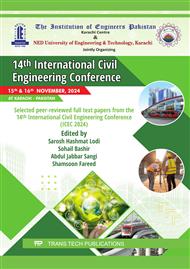[1]
P. Smith, A. Jones, and R. Taylor, " "Impact of Climate Change on Soil Organic Carbon," " Global Change Biology, vol. 28, no. 5, pp.1500-1521, 2022.
Google Scholar
[2]
P. Smith, A. Jones., and R. Taylor., "Climate change effects on soils: Organic matter decomposition and its implications for carbon storage," Nature, vol. 515, no. 7528, pp.115-122, 2014.
Google Scholar
[3]
A. Jones, P. Smith, and R. Taylor, "Effects of Changing Precipitation Patterns on Soil Moisture and Erosion," Soil Science Society of America Journal, vol. 87, no. 3, pp.987-1002, 2023.
Google Scholar
[4]
C. Brown and H. Zhang, "Extreme Weather Events and Soil Degradation: A Review," Environmental Science & Policy, vol. 118, pp.45-56, 2021.
Google Scholar
[5]
D. Pimentel, Berger, L., and D. Filiberto, Newton, M., Pimentel, M., Westra, L., " Environmental and economic costs of soil erosion and conservation benefits," Science, vol. 267, no. 5201, pp.1117-1123, 1995.
DOI: 10.1126/science.267.5201.1117
Google Scholar
[6]
E. A. Davidson and I. A. Janssens, "Temperature sensitivity of soil carbon decomposition and feedbacks to climate change," Nature, vol. 440, no. 7081, pp.165-173, 2006. [Online]. Available:.
DOI: 10.1038/nature04514
Google Scholar
[7]
R. T. Conant et al., "Temperature and soil organic matter decomposition rates–synthesis of current knowledge and a way forward," Global Change Biology, vol. 17, no. 11, pp.3392-3404, 2011. [Online]. Available:.
DOI: 10.1111/j.1365-2486.2011.02496.x
Google Scholar
[8]
E. A. Schuur and A. D. McGuire, "Climate change and the permafrost carbon feedback," Nature, vol. 520, no. 7546, pp.171-179, 2013. [Online]. Available:.
DOI: 10.1038/nature14338
Google Scholar
[9]
N. Nunan, K. Wu, I. M. Young, J. W. Crawford, and K. Ritz, "Spatial distribution of bacterial communities and their relationships with the micro-architecture of soil," FEMS Microbiology Ecology, vol. 44, no. 2, pp.203-215, 2012. [Online]. Available:.
DOI: 10.1016/s0168-6496(03)00027-8
Google Scholar
[10]
D. R. Montgomery, "Soil erosion and agricultural sustainability," Proceedings of the National Academy of Sciences, vol. 104, no. 33, pp.13268-13272, 2007. [Online]. Available:.
DOI: 10.1073/pnas.0611508104
Google Scholar
[11]
A. Borsato, S. Frisia, B. Jones, and C. Spötl, "Holocene climate variability in the Eastern Alps and the Mediterranean from speleothem records," Quaternary Science Reviews, vol. 118, pp.102-113, 2014. [Online]. Available:.
DOI: 10.1016/j.quascirev.2014.06.020
Google Scholar
[12]
B. P. Wilcox and G. L. Stoneman, "Managing water to sustain rangelands: the role of drought," Rangelands, vol. 31, no. 1, pp.10-15, 2009. [Online]. Available:.
DOI: 10.2111/1551-501X-31.1.10
Google Scholar
[13]
J. F. Fox and R. T. Koide, "Nitrogen mineralization kinetics of the rhizosphere and non-rhizosphere soil of Trifolium pratense and Lolium perenne under two soil moisture regimes," Soil Biology and Biochemistry, vol. 57, pp.144-151, 2013. [Online]. Available:.
DOI: 10.1016/j.soilbio.2012.08.019
Google Scholar
[14]
H. F. Castro, A. T. Classen, E. E. Austin, R. J. Norby, and C. W. Schadt, "Soil microbial community responses to multiple experimental climate change drivers," Applied and Environmental Microbiology, vol. 76, no. 4, pp.999-1007, 2016. [Online]. Available:.
DOI: 10.1128/AEM.02776-09
Google Scholar
[15]
K. E. Saxton and W. J. Rawls, "Soil water characteristic estimates by texture and organic matter for hydrologic solutions," Soil Science Society of America Journal, vol. 70, no. 5, pp.1569-1578, 2009. [Online]. Available:.
DOI: 10.2136/sssaj2005.0117
Google Scholar
[16]
J. Zhu and J. L. Carpenter, "Coastal salinization and agricultural production in Europe.," Agricultural Water Management, vol. 155, pp.93-101, 2015.
Google Scholar
[17]
E. A. Davidson, K. E. Savage, and A. C. Finzi, "Climate-induced variations in soil water and nutrient availability: Implications for ecosystem productivity in Australia.," Ecological Applications, vol. 24(6), pp.1476-1486, 2014.
Google Scholar


